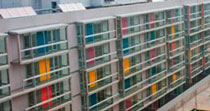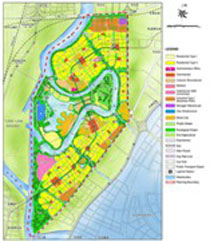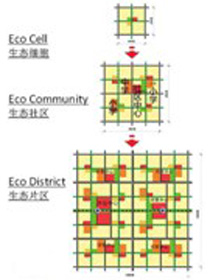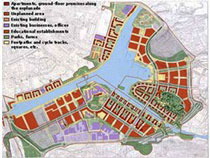
Global metaphors, and techniques for sustainability. Fabrizio Paone |
 |
Such images as “ecowebtown” and “bio-logic city” set the reader in front of exhortations pushing inside near future, signed by the incoming of new specialized energetic, productive, distributive technologies.
In Italy, in Europe and in global sense, the growing dissatisfaction towards the urban environment, in relation to the growing spread of illegal and/or attitudes which are injurious towards human rights within cities, the rise of the population and its migration towards urban habits, the political intractability of the demographic subject, the influence on world policies made by energy’s and agriculture’s big corporations, the emerging environmental crisis sets already now political attitudes and represents a strong stimulus towards urban and economic renovation.
“Sustainability”, “ecology”, “intelligence”, “bio”, “logic” are terms investing the general sense of planning, and induce to return to the disproportion among its descriptive function, and real powers recognized to it by national states, having at their time difficulties to take part into settings which appear always more global, mobile and influenced by few international global players.
The attention given to the relevance of linguistic acts in the constitution of the technical knowledge is quite intermittent within urban interpretations, and brings back to some textes and research attitudes (in primis Attilio Belli (1995), “Immagini e linguaggio. Tracce per una ricerca” , CRU n.3; Bernardo Secchi (1984), Il racconto urbanistico. La politica della casa e del territorio in Italia, Einaudi, Turin, particularly the first two chapters and, about the metaphor, pp.57-60; George Lakoff, Mark Johnson (1980), Metaphores we live by, The University of Chicago Press, Chicago and London, italian translation (1982) Metafora e vita quotidiana, L’Espresso, Milan).
From a strict point of view the metaphor of the intelligent biologic device is transferred in the urban field from experimental medicine, where bio-computer marks a micro-chirurgical set of great suggestion, where the human intervention of “reparation” is introduced within the “body” as a device able to evolve, to talk through the time with the living organism it is inserted within, exchanging with it informations and actions which are genetically relevant.
The association among city and body is ancient, and mutable. Sometimes it has been the body, read as holder of integration and hierarchy among parts, growth’s laws, pathologies, to constitute the well known term able to lighten the dark term. Sometimes it has been the city to be used as a spring of experience and of evidence in order to make the body and its movements more comprehensive.
Starting from an analogical intervention “in relation” to and “on” the living organism, the disciplinary device proposes itself as manipulation of terms and essential codes of pure life, allowing the builder and the spectators to stop close to the statement of the existence.
To the urban planner the role of “doctor”, holder of the knowledge is given in order to check the correct functioning of the organism, and to identify remedies in case of pathologies. This implies an implicitly rewarding vision for the urban planner, to whom an exclusive competence is recognized as well as a primary therapeutic role in relation to a body, the city, when is absorbed by an environment giving life’s possibility.
Starting from these considerations the question about which of the experiences under construction which have explicity placed the notion of sustainable ecologic city as an image of new ways to build the city.
An exemplary example under realization is Tianjin Eco-City, a new city for 350.000 promoted by the Chinese Government together with Singapore, whose foundation was decided in 2007 with the purpose to end the yards by 2020. The accent on its subscription as a new urban model enters in relation with Tianjin, third Chinese city as far as population is concerned, from which the new city is 40 km far, keeping close to Bejing as well, from which is separated by 150 kilometres. The attention to the production of energy, whose environmental cost becomes more and more a social and economic factor, brings Tianjin Eco-city to propose itself as “smart ecological city”, giving a particular attention to the integration between solar, aeolian and micro electric systems.
The urban design enucleates four specialized and physically recognizable districts, responding to the same number of eco-landscapes: Solarscape, Lifescape, Urbanscape, Earthscape. It’s not clear, particularly to an observer having partial a access to the documents as it is in the case of the writer, how much can be ascribed to rethorics and how much to technical arguments. The judgment on the efficacy on the proposed model will be quite difficult to pronounce at Tianjin Eco-City, which insists on an urbanized and highly polluted site, particularly as far as water is concerned. A significant observation about the city’s functioning, the inhabitants’ life styles, the energetic dissipation, should take in consideration a time sufficiently long, starting from the situation before the industrial production’s ways, to pollution, abandoning regeneration’s intervention, measurement of the obtained upgradings.
At Tianjin Eco-City the conclusion of the first part is expected by 2013.
Other recent realizations approaching the image of the “intelligent ecologic city” consist essentially in «neighborhoods», city’s parts where the wider order word of “sustainability” is experimented within the existing city.
The Ecociudad Valdespartera in Saragozza, started from 2002 from an agreement between the Municipality, the regional authority of Aragona, the Spanish Defense Ministry, measures itself with the regeneration of a wide abandoned military area through the settlement of 10.000 public dwellings. The first system of waste’s pneumatic collection in Spain is realized, and a smart strategy of checking consumes and emissions is organized, concerning at the moment about 5% of the buildings.
The project proposes a direct relation among ecological imprint and architectural shape, giving a renewed attention to building types (the collective house, more than the one family or raw houses), building’s components (the most evident data are the glass greenhouses 90 to 120 centimeters deep, South oriented), heliothermical exposure. All this gets back directly to modern urban planning’s starting themes, to the great bridge among architecture and urban planning thrown in Germany in the Twenties, of which it could be possible to live its overcoming through its direct re-proposition, with an evident paradox, or at least with the necessity to newly measure the relation between modern prototype of urban settlement, exemplar realization, ordinary city.
Different for the produced shapes but still comparable it is the Hammarby Sjiostadt’s experience, where starting from 1997 11.000 dwellings have been realized on a brown-field well connected through public transportation to the centre of Stockholm. The urban scheme, thought in the middle of the Nineties, works with the apartment building’s type, kept together through a plan made of blocks built along the perimeter, where volumetric solutions of opening of the courtyards are experimented, and non conventional technological measures, as systems of underground pneumatic pipelines relating the building courtyards with the centre of the specialized collection system located within the neighborhood, and the district heating, connected with the power plants of water treatment and waste.
The project pays particular attention to the treatment and local re-use of what before it was simply poured outside as “waste”, externality of a dominant productive ruling cycle not to be eluded, and send back to indefinite processes, to be ignored up to the moment when demonstrable and relevant negative effects don’t intervene.
In front of the realized interventions, the importance of experimentations has to be underlined, through which some public actors have produced a consistent investment in order to move the imaginary of citizens and consumers towards solutions going in the direction of a relation among man and environment making possible its aspiration to last, and to the transmission of knowledge through generations.
The question about differences happening among the promotion of strong sectorial policies within strategic fields (transportation of energy, transportation of goods and people, production of houses, distribution of income, management of waste’s cycle, habits towards consuming) and the production of an urban model, of which we could elect as a testimonial the intelligent bio-logic city arises.
At this point we could apply to a new, dense layer of textes (Max Black (1962), Models and Metaphores. Studies in Language and Philosophy, Cornell University Press, Ithaca (NY), Italian translation (1982), Modelli, archetipi, metafore, Le Pratiche Editrice, Parma; Mary B. Hesse, Models and Analogies in Science (1963), Sheed & Ward, London, New York, Italian translation (1980), Modelli e analogie nella scienza, Feltrinelli, Milan; Lorena Preta (a cura di) (1992), Immagini e metafore nella scienza, Laterza, Rome-Bari). The question is related to the time’s length of the cognitive length of the metaphor within an experimental disciplinary field, how much it ends up to melt in a series of successive proceedings, which it should have made easier and spread.
From a certain point the metaphor of the new urban model strains to dissolve, leaving the field to definite and workable techniques, from the other it seems to straighten body and city assuming a total character.
The new last years general data can maybe be assumed in a growth awareness of the integration of human settlements within biosphere, which suggests us to observe them in their “smallness” and “finiteness”, as if we would look to human world from a port hole of a spatial shuttle.
The “plans” will propose then themselves, at scales appearing always of detail, to introduce a “regulation”, an intervention on “functions”.
To think then about project devices able to start a smart ecologic city, where the urban intervention is able to land on an action on the living city, becomes a dynamic and plural challenge, positively unforeseeable, and raises a spread and democratic responsibility’s assumption of awareness and responsibility. The city’s life seems to be everywhere, everywhere its smartness.
In the last decade the growing of web’s services, the enlarging of the users’ number, of the interpersonal communications through mobile phones, sms and mms, the growth of social networks and of tablets, have reinforced the association among word and image, enabling the right to exist of each invocation to renewal, and the possibility to be communicated.
At the same time, whether if we, through the expression “smart ecologic city”, mean to build an observation tool of plans, policies and projects under realization or that in a more ambitious way try to stimulate new ways of intervention, we have to face a preliminary question. Which are the relevant informations for the biologic regulation of the new urban formula, its genetic code, in order to go on with a metaphor used by Giancarlo De Carlo during the last period of his long projectual life?
Data on the population, mobility of people and goods, infrastructural equipments? On economy, energetic consumption, emissions on the atmosphere, waste’s cycle? At which scale, with which detail, from whom measured and with which time width?
The fake opinion of the total availability and transparency of the informations evaporate very rapidly, in order to show more the partiality of the main institutions that the XX century has given to us, the Market and the State.
The polls have made pure archaeological object the big surveys of the Nineteenth century on poverty, housing, luxury, habits of the working or dangerous classes, statistical surveys on population and housing, on which most part of modern urban planning and reforming intervention was built. Other characters emerge: the big transnational enterprises of energy, food, transportation and finance, investments founds.
If we look at the urban realities changed during the last twenty years in the most evident and spectacular way, such as the Asiatic metropolis, the agreement through which the interests of the State and international finance agree in order to settle a city which through urbanization and the quantitative growth start a minimal urban condition, which is made by any kind of and low cost buildings, which possibility of being is, most of all, purely technological.
We get surprised that energy, water, urban mobility are able to support a development no asking to last, but just to exist.
 |
EWT/ EcoWebTown |






